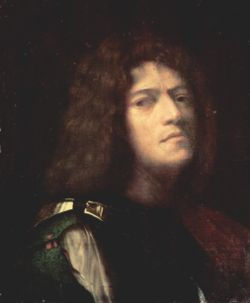(Castelfranco Veneto 1477 - Venice 1510)
Giorgione (born Giorgio Da Castelfranco) was a Venetian painter and disciple of Giovanni Bellini. His brief career was decisive to the Venetian school thanks to his developing of the tonal painting, his treatment of the light and the establishment of the modern landscaping.
In one of his first artworks, Castelfranco Madonna (1504-05), he achieved the unity of the canvas by means of oblique lighting effects over the faces, the apparel and the armor of Saint Liberalis. The artwork is arranged in two areas, outstanding the Madonna in a landscape of light tonalities.
With his work The Tempest, which is an enigmatic scene in a landscape of ruins and copses, he arrived to the top of his art and of the mastering of the most transient lighting effects. In this artwork, the abrupt decolouration of the landscape and of the objects under the purple flash of the lighting is surprising. In 1508, he and Tiziano in collaboration with him painted the frescoes of the Fondaco dei Tedeschi, from which only one battered female nude (Academia, Venice) is preserved nowadays. There was a certain esotericism in those frescoes, which is also showed in The Three Philosophers (Vienna), which were painted toward the same period.
Nowadays, the critics are in a controversial disagreement with the attribution of a series of important artworks such as Pastoral Concert, Sleeping Venus and The Concert. According to some experts, these paintings point out the period of full maturity in the evolution of Giorgione, whereas other experts state that these paintings belong to a young Titian (Tiziano). Both opinions are based on a different study and evaluation of the role both painters had in the orientation of the Venetian painting. Critics agree with the attribution of the artworks as Judith, Madonna and Child, Portrait of a Young Bride (Laura), Portrait of a Young Man, Adoration of the Shepherds and The Test of Fire of Moses to Giorgione.


